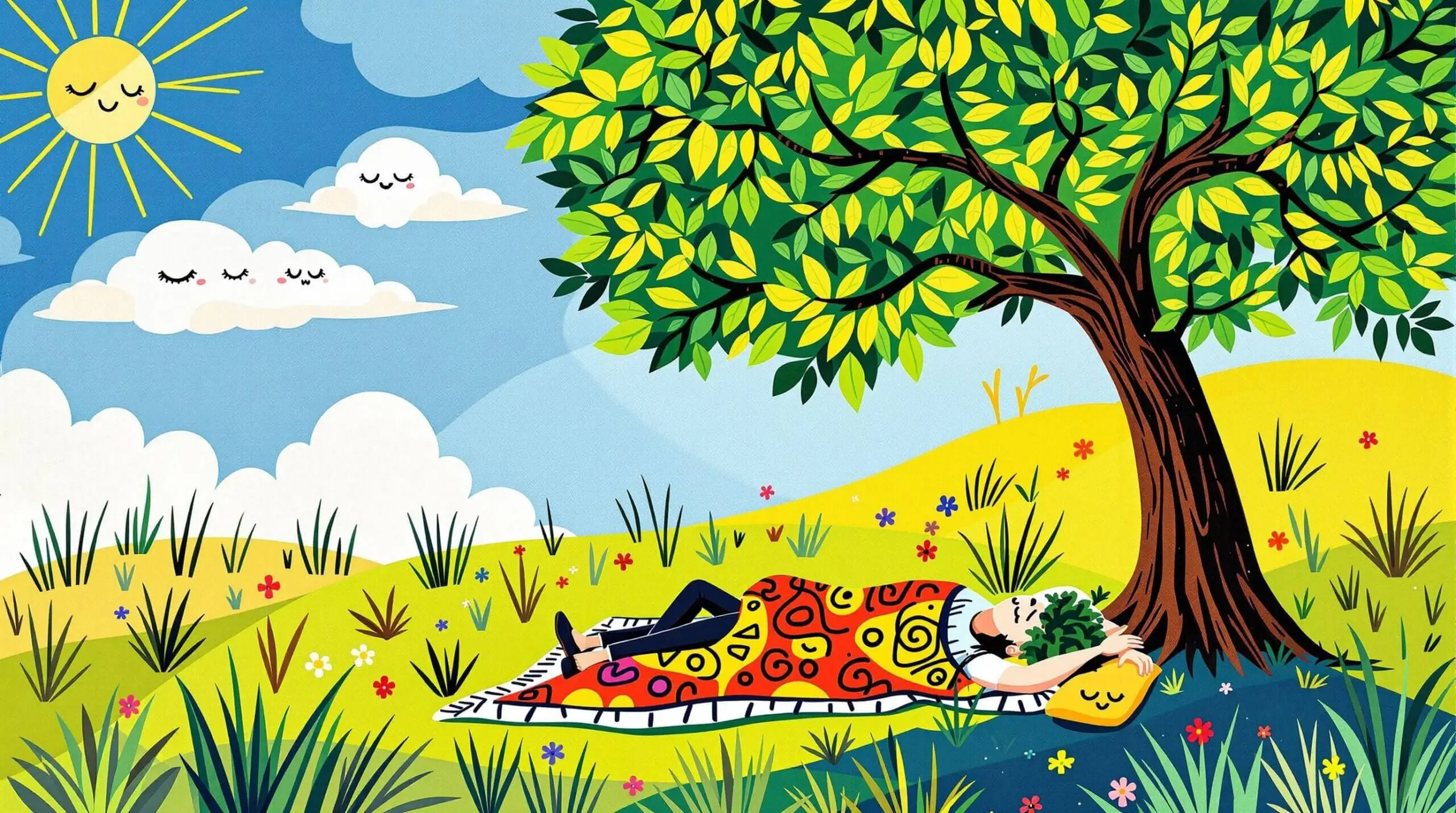Outdoor Naps: Nature’s Sleep Boost for Longevity
Discover how taking outdoor naps can enhance longevity and improve overall well-being through nature’s soothing influence.

Understanding Outdoor Naps and Longevity: The Basics
The Natural Connection Between Outdoor Sleep and Health
Sleeping outdoors isn’t just a novelty – it’s deeply rooted in our evolutionary past. Our ancestors spent countless nights under the stars, and our bodies still respond positively to outdoor rest. Modern research shows that outdoor napping can significantly improve sleep quality, reduce stress, and potentially extend lifespan.
The Science Behind Outdoor Napping
Natural light exposure during outdoor naps helps regulate our circadian rhythm – the body’s internal clock. When we nap outside, we’re exposed to beneficial elements like negative ions from fresh air and natural sounds that reduce cortisol levels. Studies indicate that spending time in nature, even during sleep, activates parasympathetic nervous system responses that promote cellular repair and regeneration.
Historical Context and Research Development
The practice of outdoor napping has deep historical roots. Nordic countries have long practiced outdoor napping for infants, reporting better sleep quality and stronger immune systems. Japanese forest bathing research shows that even brief exposure to natural environments reduces stress hormones and blood pressure – benefits that multiply during sleep.
Common Misconceptions
Many people think outdoor napping is impractical or unsafe. However, controlled outdoor environments like gardens, patios, or parks can provide safe and comfortable napping spaces. Another myth is that outdoor naps disrupt nighttime sleep – research shows the opposite. When timed correctly, outdoor naps can enhance nocturnal sleep quality.
Research Findings and Statistics
Studies show spending time outdoors increases melatonin production by 50%. Exposure to natural light during naps has been linked to a 15% improvement in sleep efficiency. Research from the University of Colorado found that camping – essentially sleeping outdoors – reset participants’ circadian rhythms within just one week.

Current Understanding of Outdoor Sleep Benefits
Modern Applications of Outdoor Napping
Contemporary research highlights multiple benefits of outdoor napping. From improved vitamin D synthesis to enhanced immune function, the advantages extend beyond basic rest. Many workplaces now incorporate outdoor rest areas, recognizing the productivity boost that comes from natural light exposure during breaks.
Environmental Factors and Sleep Quality
Temperature variations, natural sounds, and fresh air all contribute to better sleep quality outdoors. Studies show that natural temperature fluctuations help maintain optimal core body temperature for sleep. The sound of running water or rustling leaves creates a frequency pattern that promotes deeper rest states.
Physiological Impact of Outdoor Napping
Cellular Benefits and Regeneration
Outdoor napping triggers unique cellular responses. Exposure to natural light during rest periods increases the production of vitamin D, essential for cellular repair and immune function. Fresh air increases oxygen intake, supporting mitochondrial function and energy production at the cellular level.
Circadian Rhythm Optimization
Natural light exposure during outdoor naps helps synchronize our internal clock with natural day-night cycles. This alignment improves hormone regulation, metabolism, and sleep efficiency. Research shows that people who regularly expose themselves to natural light patterns have more stable circadian rhythms and better overall health outcomes.
Key Areas of Impact
Several crucial factors make outdoor napping particularly beneficial. The natural electromagnetic field exposure from the earth (grounding) may reduce inflammation. Exposure to beneficial bacteria in outdoor environments can strengthen the immune system. The combination of fresh air and natural sounds reduces mental fatigue and improves cognitive function.
Practical Implementation of Outdoor Napping
Essential Guidelines for Outdoor Napping
- Choose a safe, semi-sheltered location
- Use appropriate weather protection (shade in summer, warmth in winter)
- Time naps between 20-30 minutes for optimal benefits
- Schedule outdoor naps between 1-3 PM when possible
- Use comfortable, weather-appropriate bedding
- Protect against insects with natural repellents
- Stay hydrated before and after napping
- Choose locations with minimal urban noise
- Consider using a sleep tracking device to monitor benefits
- Start gradually with shorter sessions
Weather Considerations and Seasonal Adaptations
- Spring: Use antihistamine protection if needed
- Summer: Seek shade and use sun protection
- Fall: Layer clothing for temperature changes
- Winter: Use appropriate insulation and weather protection
- Monitor weather forecasts before planning outdoor naps
Advanced Techniques for Outdoor Napping
Optimization Strategies
To maximize the benefits of outdoor napping, timing is crucial. The ideal nap window aligns with our natural circadian dip in the early afternoon. Using natural materials like cotton or wool for bedding can enhance the connection with nature while providing comfort and temperature regulation.
Environmental Enhancement
Creating the perfect outdoor napping environment requires attention to detail. Natural sound barriers like plants can block urban noise while maintaining beneficial nature sounds. Proper positioning relative to the sun ensures optimal light exposure without overheating.
Safety and Practical Considerations
Security Measures
Safety remains paramount when napping outdoors. Choose locations with good visibility and regular foot traffic. Consider using a companion system, especially when starting this practice. Weather alerts and proper sun protection are essential components of a safe outdoor napping routine.
Health Precautions
People with certain health conditions should consult healthcare providers before starting regular outdoor napping. Allergies, skin sensitivities, and temperature regulation issues require special consideration and may need additional protective measures.
Integration with Daily Life
Work-Life Balance
Incorporating outdoor naps into a busy schedule requires planning. Many successful practitioners schedule their outdoor naps during lunch breaks or traditional siesta times. Some workplaces now provide outdoor relaxation areas, recognizing the productivity benefits of natural rest periods.
Social Aspects
Group outdoor napping can build community and accountability. Some cities have established “nap gardens” or designated outdoor rest areas. These spaces create opportunities for social connection while maintaining the health benefits of outdoor sleep.
Future Developments in Outdoor Sleep Research
Research continues to uncover new benefits of outdoor napping. Scientists are studying the impact of natural electromagnetic fields on sleep quality and cellular regeneration. Emerging evidence suggests that regular outdoor rest might influence gene expression related to longevity and stress resistance.
Long-term Benefits for Longevity
- Improved stress resistance
- Enhanced immune function
- Better cardiovascular health
- Reduced inflammation markers
- Improved mental clarity and cognitive function
- Better metabolic regulation
- Enhanced mood and emotional stability
- Stronger circadian rhythm alignment
Outdoor napping represents a simple yet powerful tool for enhancing longevity and health. By combining the natural benefits of outdoor exposure with the restorative power of sleep, we can tap into an ancestral practice that supports our modern health needs. Regular outdoor napping, when done safely and consistently, can contribute significantly to our overall well-being and potentially extend our healthy lifespan. The key lies in starting gradually, maintaining proper safety measures, and adapting the practice to individual circumstances and seasonal changes.